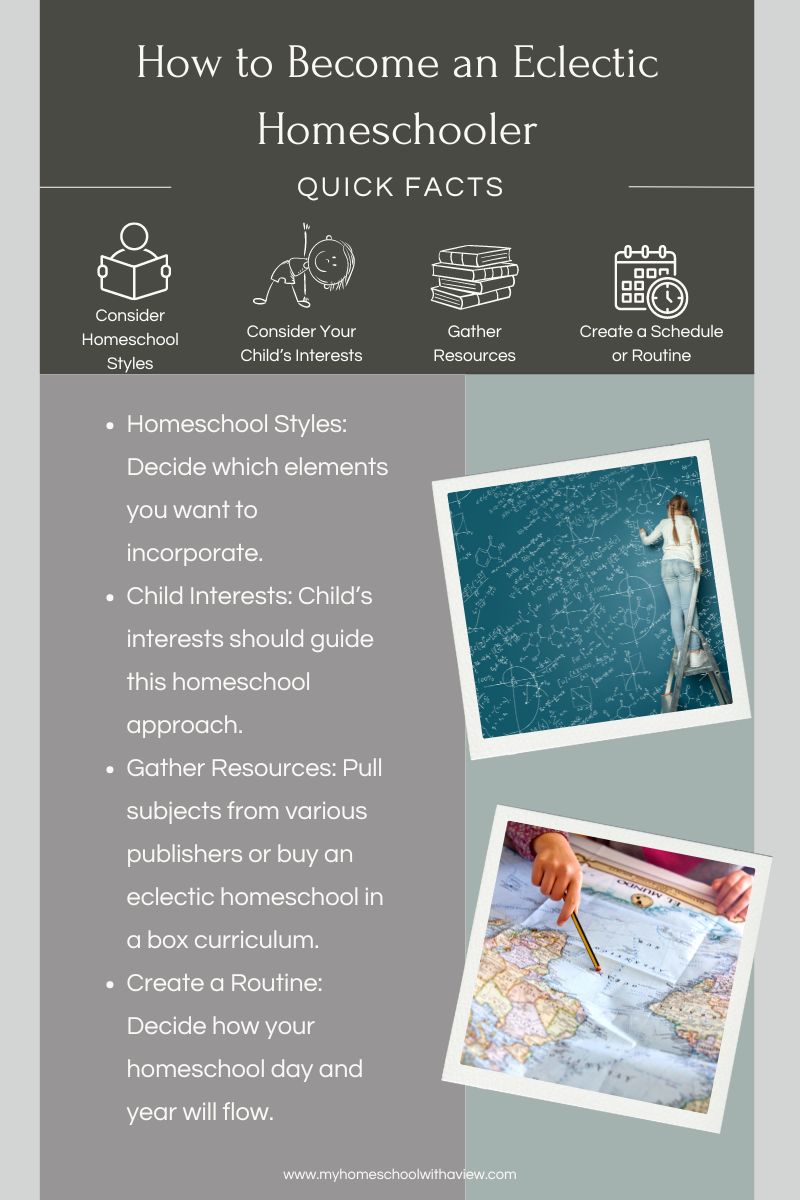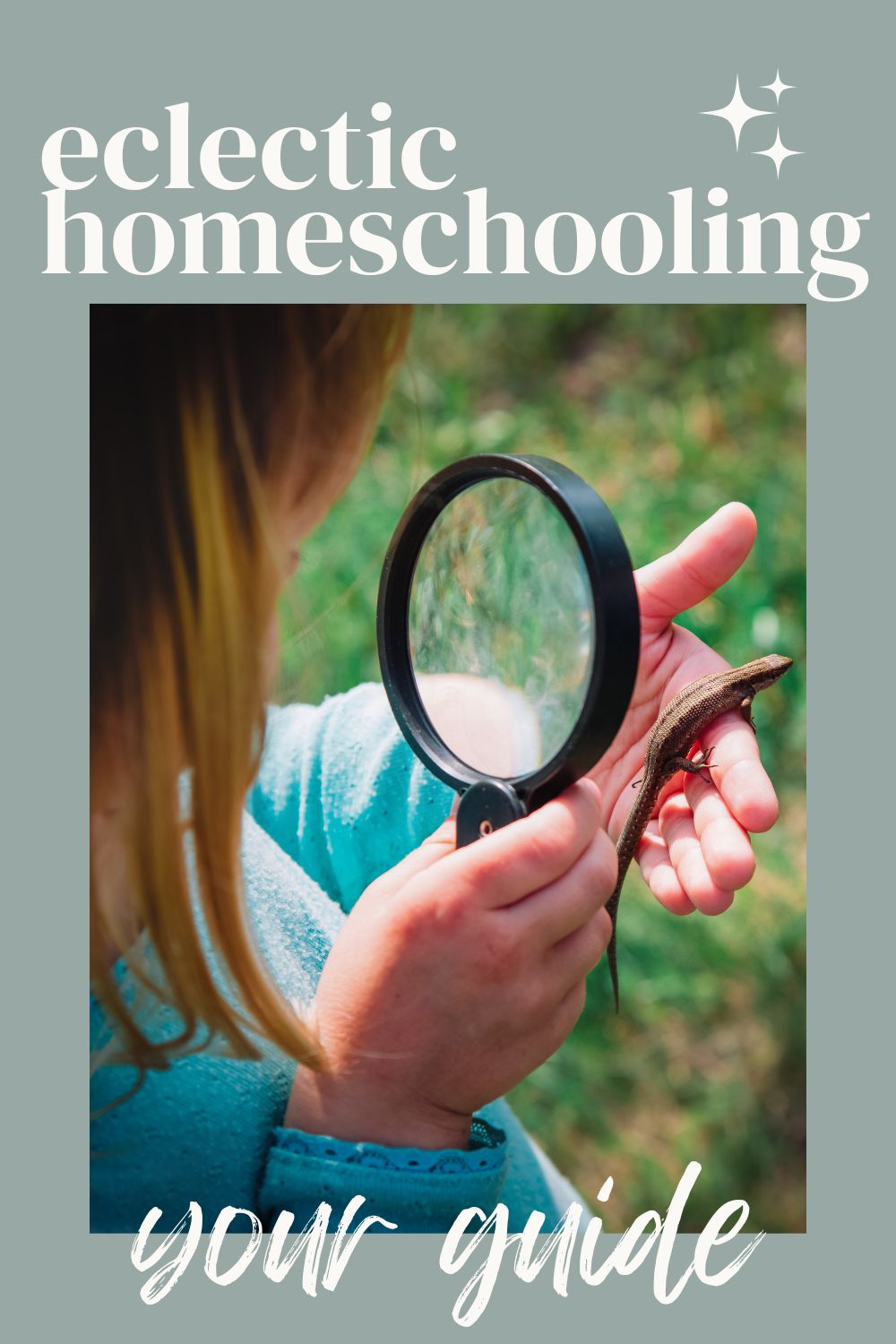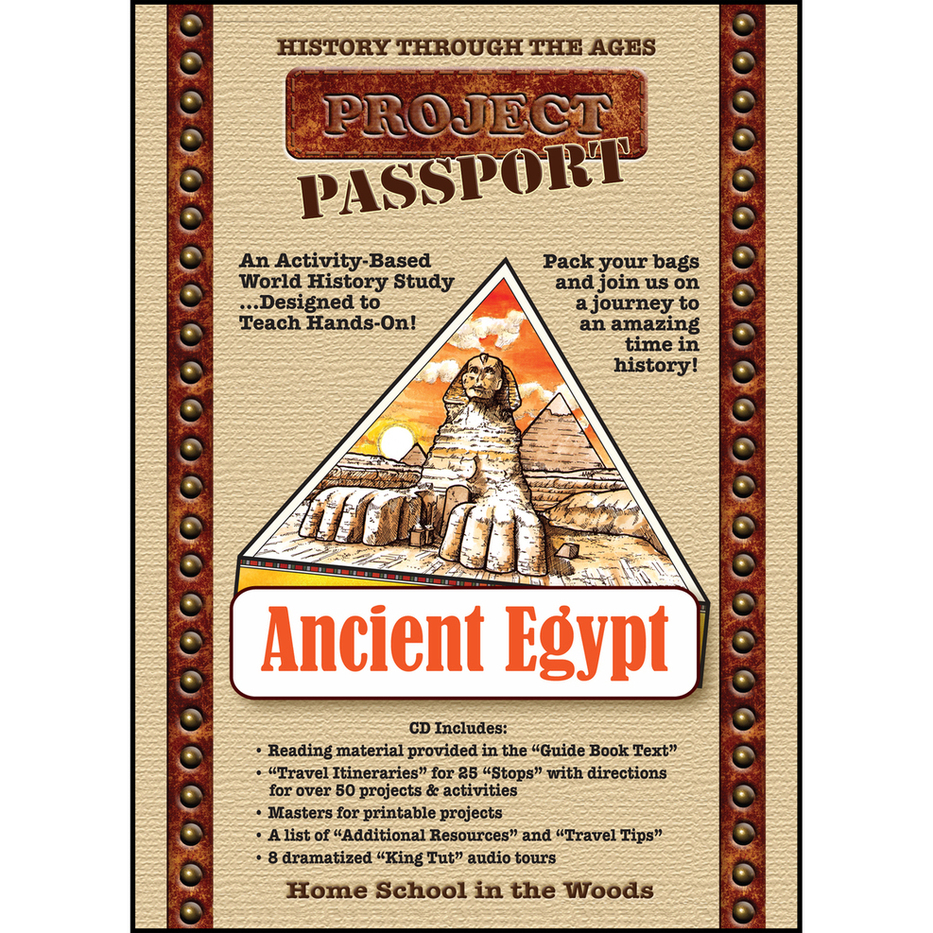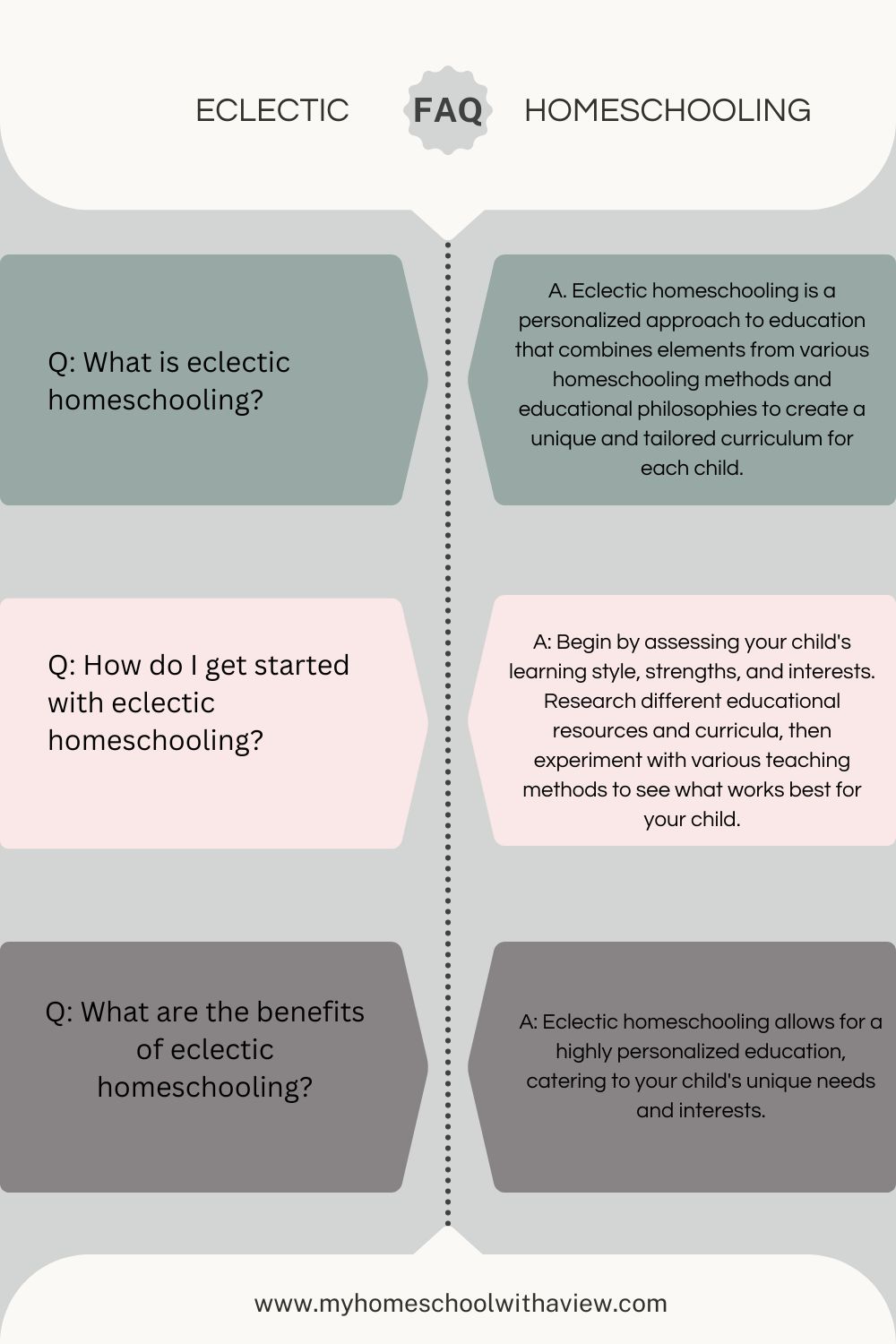This post is giving you a guide to eclectic homeschooling.
Eclectic homeschooling is one of the most flexible approaches to homeschooling you will find. It pulls from the best of all other homeschool philosophies like Charlotte Mason, traditional, classical, and even unschooling.
My choses homeschool style is eclectic homeschooling. The need to line up behind any one method or philosophy isn’t super appealing for me. Tailoring our eclectic homeschool to meet my kids needs does.
If you don’t feel like you fall in line with any one homeschool method, then eclectic homeschooling will appeal to you. In this post you will learn about eclectic homeschooling, the benefits of eclectic homeschooling, what an eclectic homeschooling plan looks like, and how to start your eclectic homeschool.
This post contains affiliate links and My Homeschool with a View, LLC participates in the Amazon Associates program. If you make a qualifying purchase through our links, we earn a commission at no additional cost to you . Thank you for supporting this site! You can read my affiliate and advertising disclosure here.
Everything You Need to Know About Eclectic Homeschooling
What is Eclectic Homeschooling
Eclectic homeschooling offers parents the opportunity to curate a tailor-made educational experience for their children. Imagine it as though you’re navigating a bustling buffet, except instead of food, you’re selecting from a wide array of homeschool styles, resources, and teaching methods. Unlike a traditional approach, where adherence to a single curriculum is the norm, eclectic homeschooling allows for a fluid and dynamic approach to your homeschool.
Picture this: your child is like a puzzle, with each piece representing their individual learning style, strengths, weaknesses, and passions. With eclectic homeschooling, you have the freedom to examine each piece of the puzzle and choose the best-fitting methods to support their growth and development. It’s about recognizing that every child is unique and honoring that uniqueness in their homeschool adventure.
Rather than adhering rigidly to one educational philosophy, such as Charlotte Mason or traditional homeschooling, eclectic homeschooling encourages you to blend elements from various approaches.
You might incorporate hands-on learning activities inspired by the Montessori method, complemented by literature-based studies and real-world experiences. This eclectic approach allows you to tap into your child’s diverse interests and learning preferences, fostering a love for learning that extends far beyond the confines of a textbook.
Ultimately, eclectic homeschooling is about embracing the freedom to chart your own homeschool course. So, as you embark on your eclectic homeschooling adventure, remember that the only rule is this: there are no rules (state laws still need to be followed).
Benefits of Eclectic Homeschooling
Why choose eclectic homeschooling? For starters, it allows you to personalize your child’s education in a way that traditional schooling often cannot.
Eclectic homeschooling puts our children as the focus of our homeschool, not a method or philosophy. By focusing on what works best for them, you can help your child engage in areas where they naturally thrive, while also challenging them in areas of difficulty.
This customized approach ensures that your child’s unique needs and learning styles are met. Afterall, this is kind of the whole point of homeschooling, isn’t it? Tailoring education to meet their needs, instead of trying to force them into a certain homeschooling method.
Moreover, eclectic homeschooling can adapt to your child’s evolving interests, making learning more engaging and enjoyable. This personalization can significantly boost your child’s confidence and motivation, as they see their progress and accomplishments in real time.
Ultimately, the freedom to select a curriculum that fits your child’s learning style, whether it’s visual, auditory, or kinesthetic, ensures that their homeschool adventure is both effective and enjoyable. This autonomy not only enhances their academic growth but also encourages them toward lifelong learning.
How to Become an Eclectic Homeschooler
Learn About Homeschool Styles
To start with this best-of-all-worlds homeschool style, learn about all of the homeschool methods. Pinpointing what resonates with you from each methodology is a good place to begin.
For example, I like the beauty of incorporating nature study, art, music and Shakespeare from Charlotte Mason homeschooling. But the structure and direct instruction of traditional homeschooling is what I prefer for skill based homeschool subjects.
Latin instruction and the developmental phases of the trivium are the parts of classical education I’ve incorporated during various seasons of homeschooling.
These are just a few examples of how you can incorporate parts of various methodologies into your eclectic homeschooling style.
Take Your Child’s Interests Into Account
This is the part of eclectic homeschooling where we can incorporate child-led learning. As homeschool moms, we often find books, resources, and homeschool styles that resonate with us. Then they tend to fall flat with our kids.
While I understand that sometimes in life we have to do things we don’t want to do, I actually don’t think homeschooling needs to be that thing for our kids. With so many resources available and different ways to present a topic, there’s really no reason to try to force a resource our kids don’t like.
Taking our kids’ interests and learning styles into account not only keeps our homeschool room from becoming a battleground of revolutionary proportions, but it also ensures engagement and buy-in from our kids.
Asking our kids what they want to learn and then allowing them to pursue those interests makes for exciting and peaceful homeschooling.
Gather Homeschool Resources
Once you have identified these areas of interest, it’s time to explore the vast resources and curriculum options available to you. Dive into research, like My Homeschool with a View Curriculum Guides, to discover materials that align with your child’s interests and learning style.
I like to narrow down curriculum choices to two or three, then I let my kids look through online samples and pick the one they like. By narrowing it down to resources that I approve of, they can experience the independence of making their own choice, and I know they are making a choice I can handle.
From textbooks and workbooks to online courses and hands-on learning kits, the possibilities are virtually endless. Don’t hesitate to reach out to other homeschooling parents or educational experts for recommendations and advice—they can offer invaluable insights based on their own experiences.
As you gather resources, don’t be afraid to mix and match materials from different sources. Unless it is a unit study curriculum that ties everything together, you will be fine getting stand-alone subjects.
Embrace the freedom to explore unconventional teaching methods and incorporate real-world experiences into your lessons—after all, learning doesn’t just happen within the confines of a textbook.
Create an Eclectic Homeschool Schedule or Routine
With your resources in hand, the final step is to create a flexible schedule that accommodates your family’s lifestyle and rhythm. Consider your child’s natural rhythms and energy levels when planning your homeschool day, and don’t be afraid to adjust your schedule as needed.
Whether you prefer a structured approach with designated lesson times or a more fluid routine that allows for spontaneous learning opportunities, find a rhythm that works for you and your child.
Implementing the Eclectic Homeschooling Style
Building Your Eclectic Homeschooling Curriculum
Crafting a curriculum for eclectic homeschooling is very much like weaving a tapestry of diverse educational philosophies. It’s about embracing the best of various approaches and tailoring them to suit your child’s unique needs and learning style.
For instance, suppose your child thrives in a structured environment and benefits from clear guidelines and goals. In that case, you might draw inspiration from the traditional schooling method and incorporate textbooks and workbooks into your curriculum. The structure of these resources can provide a solid foundation in core subjects like math, science, and language arts.
However, don’t limit yourself to traditional methods alone. Eclectic homeschooling encourages you to think outside the box and incorporate hands-on, experiential learning activities into your curriculum. Consider supplementing textbook lessons with hands-on science experiments, art projects, or nature walks. For example, rather than simply reading about photosynthesis in a textbook, why not get outside together and observe firsthand how plants grow and thrive?
Don’t underestimate the power of real-life experiences in shaping your child’s learning. Field trips to museums, historical sites, and local businesses can provide invaluable insights and bring learning to life in ways that books alone cannot.
Eclectic Homeschooling Ideas
Theme-Based Learning Unit: Ancient Egypt
-
- Classical Approach: Introduce your child to the history, mythology, and literature of Ancient Egypt using classical texts such as “The Histories” by Herodotus or “The Iliad” by Homer.
- Charlotte Mason Approach: Supplement textbook readings with living books like “Tales of Ancient Egypt” by Roger Lancelyn Green or “Mara, Daughter of the Nile” by Eloise Jarvis McGraw to bring the era to life.
- Unit Studies Approach: Design a unit study around Ancient Egypt, incorporating history, geography, art, and science. For example, explore the geography of the Nile River, create Egyptian-inspired art, conduct experiments on mummification, and study the constellations observed by ancient Egyptians.
- Unschooling Approach: Allow your child to delve deeply into areas of personal interest within the theme, whether it’s building a scale model of the Great Pyramid, learning hieroglyphics, or researching the daily life of Ancient Egyptians.
Literature-Based Learning: Shakespeare
-
- Classical Approach: Introduce your child to the works of Shakespeare, starting with simplified versions or adaptations of his plays and gradually progressing to the original texts.
- Charlotte Mason Approach: Incorporate narration and copywork exercises using passages from Shakespeare’s plays to improve language skills and comprehension.
- Unit Studies Approach: Design a unit study around a particular Shakespearean play, exploring its themes, characters, and historical context. Include activities such as staging scenes, researching Elizabethan England, and analyzing film adaptations.
- Unschooling Approach: Allow your child to explore Shakespearean themes and characters through their own creative pursuits, such as writing fan fiction, composing music inspired by the plays, or performing scenes with friends.
Science Exploration: Astronomy
- Classical Approach: Study the history of astronomy, from ancient civilizations to modern discoveries, using classical texts and primary sources.
- Charlotte Mason Approach: Conduct nature studies of the night sky, observing celestial phenomena such as phases of the moon, constellations, and planetary motion.
- Unit Studies Approach: Design a unit study around astronomy, incorporating science, math, history, and literature. Explore topics such as the solar system, stars and galaxies, space exploration, and famous astronomers.
- Unschooling Approach: Allow your child to pursue their interests within astronomy, whether it’s building a model solar system, conducting backyard stargazing sessions, or researching the latest discoveries from NASA.
By combining elements of traditional, classical, Charlotte Mason, unit studies, and unschooling approaches, you can create a dynamic and engaging eclectic homeschooling experience that caters to your child’s unique interests, learning style, and developmental stage. Experiment with different methods, adapt to your child’s changing needs, and embrace the freedom and flexibility that homeschooling affords.
Eclectic Homeschool Planning
Planning is essential for success in eclectic homeschooling. Here’s how you can effectively plan your eclectic homeschool curriculum:
Assess Your Child's Needs and Interests
- Learning Styles: Identify how your child learns best—whether they are visual, auditory, or kinesthetic learners. Tailor your teaching methods to accommodate their preferred learning style.
- Interests: Take note of your child’s interests and passions. Incorporate these interests into your curriculum to make learning more engaging and relevant for them.
Research and Select Resources
- Curriculum Options: Explore different curriculum options, including textbooks, online courses, and hands-on materials. Consider your child’s learning style, interests, and academic goals when selecting resources.
- Online Platforms: Utilize educational websites and online platforms that offer interactive lessons, videos, and games aligned with your child’s curriculum.
- Local Resources: Take advantage of local resources such as libraries, museums, and community centers. These can provide valuable learning opportunities and enrich your child’s education.
Create a Flexible Schedule
- Weekly Planner: Design a weekly planner outlining the subjects and activities you plan to cover each day. Be flexible and willing to adjust your schedule as needed based on your child’s progress and interests.
- Daily Routine: Establish a daily routine that includes dedicated time for learning, breaks, and extracurricular activities. Balance structured learning activities with free play and exploration to keep your child engaged and motivated.
Adapt and Modify Teaching Methods
- Individualized Instruction: Adapt your teaching methods to meet your child’s individual needs and learning pace. Provide additional support or challenges as needed to ensure academic growth and success.
- Multi-Sensory Learning: Incorporate multi-sensory learning activities that engage your child’s senses and reinforce key concepts. Use manipulatives, visuals, and hands-on experiments to make learning more interactive and memorable.
- Real-World Application: Connect classroom learning to real-world experiences whenever possible. Take field trips, conduct experiments, and engage in project-based learning to help your child see the relevance and practical applications of what they are learning.
Evaluate and Adjust
- Feedback: Encourage open communication with your child and solicit their feedback on their homeschool experience. Be receptive to their input and suggestions for improvement.
- Flexibility: Be willing to adapt and adjust your eclectic homeschooling approach based on your child’s evolving needs, interests, and learning experiences. Embrace the flexibility that homeschooling offers and make changes as necessary to ensure continued growth and success.
Overcoming Challenges in Eclectic Homeschooling
Like any educational approach, eclectic homeschooling has its challenges. Balancing structure and flexibility can be tricky, but it’s essential to find a routine that works for your family. And don’t let external criticism get you down. Trust your instincts and focus on what’s best for your child.
Some groups that follow certain homeschool philosophies will tell you that you have to be a purist or follow one homeschool style completely. This is totally untrue. You can draw from the best parts of each method while creating a comprehensive and enriching homeschool plan for your family.
Your content goes here. Edit or remove this text inline or in the module Content settings. You can also style every aspect of this content in the module Design settings and even apply custom CSS to this text in the module Advanced settings.
Eclectic Homeschooling FAQ
1. What is eclectic homeschooling?
Eclectic homeschooling is a personalized approach to education that combines elements from various homeschooling methods and educational philosophies to create a unique and tailored curriculum for each child.
2. How do I get started with eclectic homeschooling?
Begin by assessing your child’s learning style, strengths, and interests. Research different educational resources and curricula, then experiment with various teaching methods to see what works best for your child. Gradually build a flexible schedule that fits your family’s routine.
3. What are the benefits of eclectic homeschooling?
Eclectic homeschooling allows for a highly personalized education, catering to your child’s unique needs and interests. It promotes a holistic learning experience by integrating diverse subjects and skills, and provides the flexibility to adapt the curriculum as your child grows and their interests change.
4. How do I choose the right resources for eclectic homeschooling?
Explore a variety of educational resources, including textbooks, online courses, hands-on materials, and living books. Select resources that align with your child’s learning style and interests. Don’t be afraid to mix and match different materials to create a comprehensive learning experience.
5. How flexible is eclectic homeschooling?
Eclectic homeschooling is highly flexible, allowing you to adapt the curriculum and schedule to fit your child’s evolving needs and interests. You can adjust the pace of learning, switch resources, and incorporate new teaching methods as needed.
6. How can I incorporate different homeschooling styles into eclectic homeschooling?
Blend elements from various educational philosophies, such as the classical approach, Charlotte Mason, unit studies, and unschooling. Use traditional textbooks for core subjects, integrate hands-on activities and nature studies, design thematic units, and allow child-led learning experiences.
7. Can I include extracurricular activities in eclectic homeschooling?
Absolutely! Extracurricular activities, such as sports, music, art, and community service, are an important part of a well-rounded education. They provide opportunities for social interaction, skill development, and personal growth.
8. How can I stay organized with eclectic homeschooling?
Use planners, checklists, and digital tools to keep track of lesson plans, resources, and your child’s progress. Establish a routine that includes regular review and adjustment of your homeschooling approach to ensure it remains effective and engaging for your child.
This post is all about eclectic homeschooling.
Other posts you will like:
Master Homeschooling with Engaging Unit Studies: Your Complete Guide
Everything You Need To Know About Traditional Homeschooling
Charlotte Mason Homeschooling: Unveiling a Beautiful Education – My Homeschool with a View








